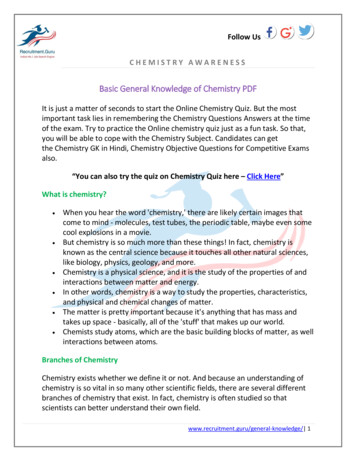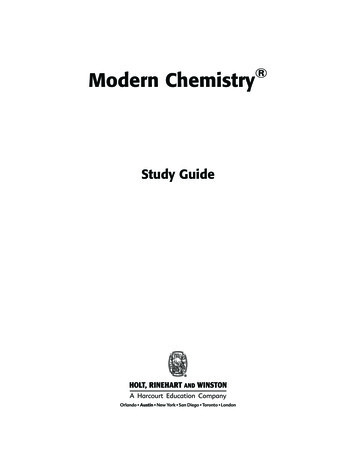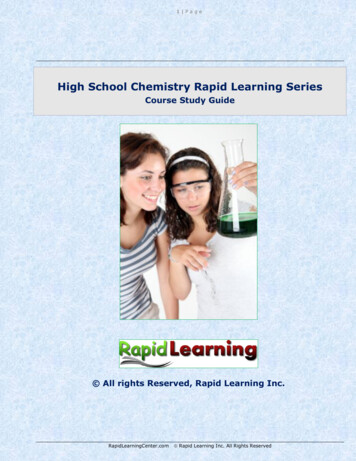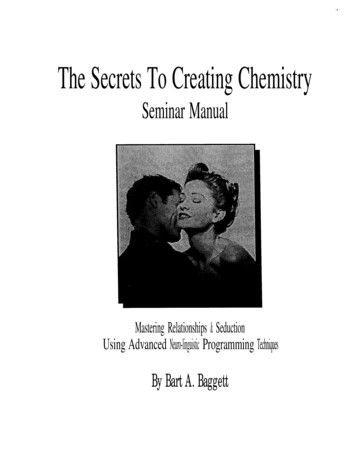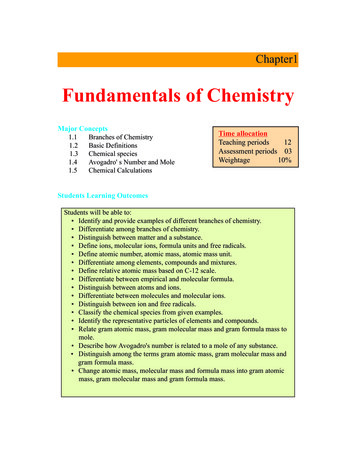
Transcription
Chapter1Fundamentals of ChemistryMajor Concepts1.1Branches of Chemistry1.2Basic Definitions1.3 Chemical species1.4Avogadro' s Number and Mole1.5Chemical CalculationsTime allocationTeaching periods12Assessment periods 03Weightage10%Students Learning OutcomesStudents will be able to: Identify and provide examples of different branches of chemistry. Differentiate among branches of chemistry. Distinguish between matter and a substance. Define ions, molecular ions, formula units and free radicals. Define atomic number, atomic mass, atomic mass unit. Differentiate among elements, compounds and mixtures. Define relative atomic mass based on C-12 scale. Differentiate between empirical and molecular formula. Distinguish between atoms and ions. Differentiate between molecules and molecular ions. Distinguish between ion and free radicals. Classify the chemical species from given examples. Identify the representative particles of elements and compounds. Relate gram atomic mass, gram molecular mass and gram formula mass tomole. Describe how Avogadro's number is related to a mole of any substance. Distinguish among the terms gram atomic mass, gram molecular mass andgram formula mass. Change atomic mass, molecular mass and formula mass into gram atomicmass, gram molecular mass and gram formula mass.
Chemistry - IX2Unit 1: Fundamentals of ChemistryIntroductionThe knowledge that provides understanding of this world and how it works, isscience. The branch of science which deals with the composition, structure, propertiesand reactions of matter is called chemistry. It deals with every aspect of our life.The development of science and technology has provided us a lot of facilities indaily life. Imagine the role and importance of petrochemical products, medicines anddrugs, soap, detergents, paper, plastics, paints and pigments, insecticides, pesticideswhich all are fruit of the efforts of chemists. The development of chemical industry hasalso generated toxic wastes, contaminated water and polluted air around us. On the otherhand, chemistry also provides knowledge and techniques to improve our health andenvironment and to explore and to conserve the natural resources.In this chapter, we will study about different branches of chemistry, basicdefinitions and concepts of chemistry.1.1BRANCHES OF CHEMISTRYIt is a fact that we live in the world of chemicals. We all depend upon differentliving organisms which require water, oxygen or carbon dioxide for their survival.Today chemistry has a wide scope in all aspects of life and is serving the humanityday and night. Chemistry is divided into following main branches: physicalchemistry, organic chemistry, inorganic chemistry, biochemistry, industrial chemistry,nuclear chemistry, environmental chemistry and analytical chemistry.1.1.1Physical ChemistryPhysical Chemistry is defined as the branch of chemistry that deals with therelationship between the composition and physical properties of matter along with thechanges in them. The properties such as structure of atoms or formation of moleculesbehavior of gases, liquids and solids and the study of the effect of temperature orradiation on matter are studied under this branch.1.1.2Organic ChemistryOrganic Chemistry is the study of covalent compounds of carbon and hydrogen(hydrocarbons) and their derivatives. Organic compounds occur naturally and are alsosynthesized in the laboratories. Organic chemists determine the structure and propertiesof these naturally occurring as well as synthesized compounds. Scope of this branchcovers petroleum, petrochemicals and pharmaceutical industries.1.1.3Inorganic ChemistryInorganic chemistry deals with the study of all elements and their compoundsexcept those of compounds of carbon and hydrogen (hydrocarbons) and theirderivatives. It has applications in every aspect of the chemical industry such as glass,cement, ceramics and metallurgy (extraction of metals from ores).
Chemistry - IX3Unit 1: Fundamentals of Chemistry1.1.4BiochemistryIt is the branch of chemistry in which we study the structure, composition, andchemical reactions of substances found in living organisms. It covers all chemicalprocesses taking place in living organisms, such as synthesis and metabolism ofbiomolecules like carbohydrates, proteins and fats. Biochemistry emerged as a separatediscipline when scientists began to study how living things obtain energy from food orhow the fundamental biological changes occur during a disease. Examples ofapplications of biochemistry are in the fields of medicine, food science and agriculture,etc.1.1.5Industrial ChemistryThe branch of chemistry that deals with the manufacturing of chemicalcompounds on commercial scale, is called industrial chemistry. It deals with themanufacturing of basic chemicals such as oxygen, chlorine, ammonia, caustic soda,nitric acid and sulphuric acid. These chemicals provide the raw materials for many otherindustries such as fertilizers, soap, textiles, agricultural products, paints and paper, etc.1.1.6Nuclear ChemistryNuclear Chemistry is the branch of chemistry that deals with the radioactivity,nuclear processes and properties. The main concern of this branch is with the atomicenergy and its uses in daily life. It also includes the study of the chemical effects resultingfrom the absorption of radiation within animals, plants and other materials. It has vastapplications in medical treatment (radiotherapy), preservation of food and generation ofelectrical power through nuclear reactors, etc.1.1.7Environmental ChemistryIt is the branch of chemistry in which we study about components of theenvironment and the effects of human activities on the environment. Environmentalchemistry is related to other branches like biology, geology, ecology, soil and water. Theknowledge of chemical processes taking place in environment is necessary for itsimprovement and protection against pollution.1.1.8Analytical ChemistryAnalytical chemistry is the branch of chemistry that deals with separation andanalysis of a sample to identify its components. The separation is carried out prior toqualitative and quantitative analysis. Qualitative analysis provides the identity of asubstance (composition of chemical species). On the other hand, quantitative analysisdetermines the amount of each component present in the sample. Hence, in this branchdifferent techniques and instruments used for analysis are studied. The scope of thisbranch covers food, water, environmental and clinical analysis.
4Chemistry - IXi.ii.iii.iv.v.Test yourself1.11.2vi.Unit 1: Fundamentals of ChemistryIn which branch of chemistry behaviour of gases and liquids isstudied?Define biochemistry?Which branch of chemistry deals with preparation of paints andpaper?In which branch of chemistry the metabolic processes ofcarbohydrates and proteins are studied?Which branch of chemistry deals with atomic energy and its usesin daily life?Which branch of chemistry deals with the structure andproperties of naturally occurring molecules?BASIC DEFINITIONSMatter is simply defined as anything that has mass and occupies space. Ourbodies as well as all the things around us are examples of matter. In chemistry, we studyall types of matters that can exist in any of three physical states: solid, liquid or gas.A piece of matter in pure form is termed as a substance. Every substance has afixed composition and specific properties or characteristics. Whereas, impure matter iscalled a mixture; which can be homogeneous or heterogeneous in its composition.We know that every substance has physical as well as chemical properties. Theproperties those are associated with the physical state of the substance are calledphysical properties like colour, smell, taste, hardness, shape of crystal, solubility,melting or boiling points, etc. For example, when ice is heated, it melts to form water.When water is further heated, it boils to give steam. In this entire process only thephysical states of water change whereas its chemical composition remains the same.The chemical properties depend upon the composition of the substance. When asubstance undergoes a chemical change, its composition changes and a new substancesare formed. For example, decomposition of water is a chemical change as it produceshydrogen and oxygen gases. All materials are either a substance or a mixture. Figure 1.1shows simple classification of the matter into different HetrogeneousmixtureSubstanceElementsFig. 1.1. Classification of matterCompounds
5Chemistry - IXUnit 1: Fundamentals of Chemistry1.2.1 Elements, Compounds and Mixtures1.2.1.1 ElementsIn the early ages, only nine elements (carbon, gold, silver, tin, mercury, lead,copper, iron and sulphur) were known. At that time, it was considered that elements werethe substances that could not be broken down into simpler units by ordinary chemicalprocesses. Until the end of nineteenth century, sixty-three elements had been discovered.Now 118 elements have been discovered, out of which 92 are naturally occurringelements. Modern definition of element is that it is a substance made up of same type ofatoms, having same atomic number and cannot be decomposed into simple substancesby ordinary chemical means. It means that each element is made up of unique type ofatoms that have very specific properties.Elements occur in nature in free or combined form. All the naturally occurringelements found in the world have different percentages in the earth's crust, oceans andatmosphere. Table 1.1. shows natural occurrence in percentage by weight of some majorelements around us. It shows concentrations of these major elements found in the threemain systems of our environment.Table 1.1 Natural Occurrences by Weight % of Some Major Elements‘s crustElements may be solids, liquids or gases. Majority of the elements exist as solidse.g. sodium, copper, zinc, gold, etc. There are very few elements which occur in liquidstate e.g. mercury and bromine. A few elements exist as gases e.g. nitrogen, oxygen,chlorine and hydrogen.On the basis of their properties, elements are divided into metals, non-metals andmetalloids. About 80 percent of the elements are metals.
Chemistry - IXDo you know?6Unit 1: Fundamentals of ChemistryMajor part of a living body is made up of water i.e. 65% to 80% bymass.Six elements constitute about 99% of our body mass; namely:Oxygen 65 %, Carbon 18%, Hydrogen 10 %, Nitrogen 3%,Calcium 1.5% and Phosphorus 1.5%.Potassium, Sulphur, Magnesium and Sodium constitute 0.8% ofour body mass. Whereas Copper, Zinc, Fluorine, Chlorine, Iron,Cobalt and Manganese constitute only 0.2% of our body mass.Elements are represented by symbols, which are abbreviations for the name ofelements. A symbol is taken from the name of that element in English, Latin, Greek orGerman. If it is one letter, it will be capital as H for Hydrogen, N for Nitrogen and C forCarbon etc. In case of two letters symbol, only first letter is capital e.g. Ca for Calcium,Na for Sodium and Cl for Chlorine.The unique property of an element is valency. It is combining capacity of anelement with other elements. It depends upon the number of electrons in the outermostshell.In simple covalent compounds, valency is the number of hydrogen atoms whichcombine with one atom of that element or the number of bonds formed by one atom ofthat element e.g. in the following compounds.The valency of chlorine, oxygen, nitrogen and carbon is 1, 2, 3 and 4, respectively.In simple ionic compounds valency is the number of electrons gained or lost byan atom of an element to complete its octet. Elements having less than four electrons intheir valence shell; prefer to lose the electrons to complete their octet. For example,atoms of Na, Mg and Al have 1, 2 and 3 electrons in their valence shells respectively.They lose these electrons to have valency of 1, 2 and 3, respectively. On the other hand,elements having five or more than five electrons in their valence shells, gain electrons tocomplete their octet. For example, N, O and Cl have 5, 6 and 7 electrons in their valenceshells respectively. They gain 3, 2 and 1 electrons respectively to complete their octet.Hence, they show valency of 3, 2 and 1, respectively. A radical is a group of atoms thathave some charge. Valencies of some common elements and radicals are shown in Table1.2.
Chemistry - IX7Unit 1: Fundamentals of ChemistryTable 1.2 Some Elements and Radicals with their Symbols and CommonValenciesSome elements show more than one valency, i.e. they have variable valency. Forexample, in ferrous sulphate (FeSO4) the valency of iron is 2. In ferric sulphate(Fe2(SO4)3), the valency of iron is 3. Generally, the Latin or Greek name for the element(e.g., Ferrum) is modified to end in 'ous' for the lower valency (e.g. Ferrous) and to end in'ic' for the higher valency (e.g. Ferric).1.2.1.2 CompoundCompound is a substance made up of two or more elements chemically combinedtogether in a fixed ratio by mass. As a result of this combination, elements lose their ownproperties and produce new substances (compounds) that have entirely differentproperties. Compounds can't be broken down into its constituent elements by simplephysical methods. For example, carbon dioxide is formed when elements of carbon andoxygen combine chemically in a fixed ratio of 12:32 or 3:8 by mass. Similarly, water is acompound formed by a chemical combination between hydrogen and oxygen in a fixedratio of 1:8 by mass.
8Chemistry - IXUnit 1: Fundamentals of ChemistryCompounds can be classified as ionic or covalent. Ionic compounds do not existin independent molecular form. They form a three dimensional crystal lattice, in whicheach ion is surrounded by oppositely charged ions. These oppositely charged ions attracteach other very strongly, as a result ionic compounds have high melting and boilingpoints. These compounds are represented by formula units e.g. NaCl, KBr, CuSO4.The covalent compounds mostly exist in molecular form. A molecule is a truerepresentative of the covalent compound and its formula is called molecular formulae.g. H2O, HC1, H2SO4, Ch4.Table 1.3 Some Common Compounds with their FormulaeRememberAlways use:Standard symbols of elementsChemical formulae of compoundsProper abbreviations of scientific termsStandard values and SI units for constants1.2.1.3 MixtureWhen two or more elements or compounds mix up physically without any fixedratio, they form a mixture. On mixing up, the component substances retain their ownchemical identities and properties. The mixture can be separated into parent componentsby physical methods such as distillation, filtration, evaporation, crystallisation ormagnetization. Mixtures that have uniform composition throughout are calledhomogeneous mixtures e.g. air, gasoline, ice cream. Whereas, heterogeneous mixturesare those in which composition is not uniform throughout e.g. soil, rock and wood.
9Chemistry - IXUnit 1: Fundamentals of ChemistryAir is a mixture of nitrogen, oxygen, carbon dioxide, noble gases andwater vapours.Soil is a mixture of sand, clay, mineral salts, water and air.Milk is a mixture of water, sugar, fat, proteins, mineral salts and vitamins.Brass is a mixture of copper and zinc metals.Do you know?Table 1.4 Difference between a Compound and a MixtureCompoundMixtureiIt is formed by a chemical combination of Mixture is formed by the simple mixingatoms of the elements.up of the substances.ii.The constituents lose their identity andform a new substance having entirelydifferent properties from them.iii. Compounds always have fixedcomposition by mass.iv. The components cannot be separated byphysical means.v.Mixture shows the properties of theconstituents.Mixtures do not have fixed composition.The components can be separated bysimple physical methods.Every compound is represented by achemical formula.It consists of two or more componentsand does not have any chemicalformula.vi. Compounds have homogeneousThey may be homogeneous orcomposition.heterogeneous in compositionvii. Compounds have sharp and fixed melting Mixtures do not have sharp and fixedpointsmelting points.i.Test yourself1.2Can you identify mixture, element or compound out of thefollowing:Coca cola, petroleum, sugar, table salt, blood, gun powder, urine,aluminium, silicon, tin, lime and ice cream.ii.How can you justify that air is a homogenous mixture. Identifysubstances present in it.iii. Name the elements represented by the following symbols:Hg, Au, Fe, Ni, Co, W, Sn, Na, Ba, Br, Bi.iv.Name a solid, a liquid and a gaseous element that exists at theroom temperature.v.Which elements do the following compounds contain?Sugar, common salt, lime water and chalk.1.2.1 Atomic Number and Mass NumberThe atomic number of an element is equal to the number of protons present inthe nucleus of its atoms. It is represented by symbol ‘Z’ . As all atoms of an element havethe same number of protons in their nuclei, they have the same atomic number.
Chemistry - IX10Unit 1: Fundamentals of ChemistryHence, each element has a specific atomic number termed as its identificationnumber. For example, all hydrogen atoms have 1 proton, their atomic number is Z l. Allatoms in carbon have 6 protons, their atomic number is Z 6. Similarly, in oxygen allatoms have 8 protons having atomic number Z 8 and sulphur having 16 protons showsatomic number Z 16.The mass number is the sum of number of protons and neutrons present in thenucleus of an atom. It is represented by symbol 'A'.It is calculated as A Z nwhere n is the number of neutrons.Each proton and neutron has lamu mass. For example, hydrogen atom has oneproton and no neutron in its nucleus, its mass number A l 0 1. Carbon atom has 6protons and 6 neutrons, hence its mass number A 12. Atomic numbers and massnumbers of a few elements are given in Table 1.5Table 1.5 Some Elements along with their Atomic and Mass NumbersExample 1.1How many protons and neutrons are there in an atom having A 238 and Z 92.Solution:First of all, develop data from the given statement of the example and then solve it withthe help of data.DataA 238Z 92Number of protons ?Number of neutrons?Number of protons Z 92
11Chemistry - IXUnit 1: Fundamentals of ChemistryNumber of Neutrons A- Z 238 – 92 1461.2.3 Relative Atomic Mass and Atomic Mass UnitAs we know that the mass of an atom is too small to be determined practically.However, certain instruments enable us to determine the ratio of the atomic masses ofvarious elements to that of carbon-12 atoms. This ratio is known as the relative atomicmass of the element. The relative atomic mass of an element is the average mass of theatoms of that element as compared to 1/12th (one-twelfth) the mass of an atom of carbon12 isotope (an element having different mass number but same atomic number). Basedon carbon-12 standard, the mass of an atom of carbon is 12 units and l/2th of it comes to be1 unit. When we compare atomic masses of other elements with atomic mass of carbon12 atom, they are expressed as relative atomic masses of those elements. The unit forrelative atomic masses is called atomic mass unit, with symbol 'amu'. One atomic massunit is 1/12th the mass of one atom of carbon-12th. When this atomic mass unit isexpressed in grams, it is:For example:Test yourself1.3i)ii)iii)iv)v)How many amu 1 g of a substance has?Is atomic mass unit a SI unit of an atomic mass?What is the relationship between atomic number and atomic mass?Define relative atomic mass.Why atomic mass of an atom is defined as relative atomic mass?1.2.4 How to write a Chemical FormulaCompounds are represented by chemicalformulae as elements are represented bysymbols. Chemical formulae of compounds arewritten keeping the following steps inconsideration.i.ii.Symbols of two elements are writtenside by side, in the order of positive ionfirst and negative ion later.The valency of each ion is writtenon the right top corner of itssymbol, e.g. Na , Ca2 , CI and O2 .It representsthe name of thesubstance e.g.H2O (water).It alsoIt tells therepresentsname of theone mole ofelementsthe moleculesas presentSignificancein the balancedin theofchemicalcompound.chemicalequation.formulaIt is in factIt indicatesone molecule orthe mass of thecompound in amus formula unit ofthe compound.or grams.
Chemistry - IX12Unit 1: Fundamentals of Chemistryiii. This valency of each ion is brought to the lower right corner of other ion by 'crossexchange' method, e.g.They are written as:iv. If the valencies are same, they are offset and are not written in the chemicalformula. But if they are different, they are indicated as such at the same position,e.g. in case of sodium chloride both the valencies are offset and formula is writtenas NaCl, whereas, calcium chloride is represented by formula CaCl2.v.If an ion is a combination of two or more atoms which is called radical, bearing anet charge on it, e.g. SO42 (sulphate) and PO43 (phosphate), then the net chargerepresents the valency of the radical. The chemical formula of such compounds iswritten as explained in (iii) and (iv); writing the negative radical within theparenthesis. For example, chemical formula of aluminium sulphate is written asAl2(SO4)3 and that of calcium phosphate as Ca3(PO4)2.1.2.4.1 Empirical formulaChemical formulae are of two types. The simplest type of formula is empiricalformula. It is the simplest whole number ratio of atoms present in a compound. Theempirical formula of a compound is determined by knowing the percentage compositionof a compound. However, here we will explain it with simple examples.The covalent compound silica (sand) has simplest ratio of 1:2 of silicon andoxygen respectively. Therefore, its empirical formula is SiO2. Similarly, glucose hassimplest ratio 1:2:1 of carbon, hydrogen and oxygen, respectively. Hence, its empiricalformula is CH2O.As discussed earlier, the ionic compounds exist in three dimensional networkforms. Each ion is surrounded by oppositely charged ions in such a way to formelectrically neutral compound. Therefore, the simplest unit taken as a representative ofan ionic compound is called formula unit. It is defined as the simplest whole numberratio of ions, as present in the ionic compound. In other words, ionic compounds haveonly empirical formulae. For example, formula unit of common salt consists of one Na and one CI ion and its empirical formula is NaCl. Similarly, formula unit of potassiumbromide is KBr, which is also its empirical formula.1.2.4.2 Molecular Formula
Chemistry - IX13Unit 1: Fundamentals of ChemistryMolecules are formed by the combination of atoms. These molecules arerepresented by molecular formulae that show actual number of atoms of each elementpresent in a molecule of that compound. Molecular formula is derived from empiricalformula by the following relationship:Molecular formula (Empirical formula)nWhere n is 1,2,3 and so on.For example, molecular formula of benzene is C6H6 which is derived from theempirical formula CH where the value of n is 6.The molecular formula of a compound may be same or a multiple of the empiricalformula. A few compounds having different empirical and molecular formulae areshown in Table 1.6.Table 1.6 Some Compounds with their Empirical and Molecular FormulaeSome compounds may have same empirical and molecular formula e.g. water (H20),hydrochloric acid (HC1), etc.1.2.5 Molecular Mass and Formula MassThe sum of atomic masses of all the atoms present in one molecule of a molecularsubstance, is its molecular mass. For example, molecular mass of chlorine (Cl2) is 71.0amu, of water (H2O) is 18 amu and that of carbon oxide (CO2) is 44 amu.Example 1.2Calculate the molecular mass of Nitric acid, HNO3.SolutionAtomic mass of H 1 amuAtomic mass of N 14 amuAtomic mass of O 16 amuMolecular formula HNO3Molecular mass 1 (At. mass of H) 1 (At. mass of N) 3 (At. mass of O) 1 14 3(16) 1 14 48 63 amuSome ionic compounds that form three dimensional solid crystals, are representedby their formula units. Formula mass in such cases is the sum of atomic masses of all theatoms present in one formula unit of a substance. For example, formula mass of sodiumchloride is 58.5 amu and that of CaCO3 is 100 amu.
14Chemistry - IXUnit 1: Fundamentals of ChemistryExample 1.3Calculate the formula mass of Potassium sulphate K2SO4SolutionAtomic mass of KAtomic mass of SAtomic mass of OFormula unitFormula mass of K2SO4 39 amu32 amu16 amuK2SO42(39) 78 174 amu1(32)32 4(16)64i.ii.What is the relationship between empirical formula and formula unit?How can you differentiate between molecular formula and empiricalformula?iii. Identify the following formulae as formulas or unit molecular formulae:H2O2, CH4, C6H12O6, C12H22O1, BaCO3, KBriv. What is empirical formula of acetic acid (CH3COOH)?Find out its molecular mass.Test yourselfv.Calculatethe formula masses of:1.3 CHEMICALSPECIES1.4Na2S04, ZnSO4 and CuCO3.1.3.1 Ions (Cations and Anions), Molecular Ions and Free RadicalsIon is an atom or group of atoms having a charge on it. The charge may be positiveor negative. There are two types of ions i.e. cations and anions. An atom or group ofatoms having positive charge on it is called cation. The cations are formed when atomslose electrons from their outermost shells. For example, Na , K are cations. Thefollowing equations show the formation of cations from atoms.An atom or a group of atoms that has a negative charge on it, is called anion. Anionis formed by the gain or addition of electrons to an atom. For example, Cl and O2 .Following examples show the formation of an anion by addition of electrons to an atom.Table 1.7 Difference between Atoms and Ions
15Chemistry - IXUnit 1: Fundamentals of Chemistry1.3.1.1 Molecular IonWhen a molecule loses or gains an electron, it forms a molecular ion. Hence,molecular ion or radical is a species having positive or negative charge on it. Like otherions they can be cationic molecular ions (if they carry positive charge) or anionicmolecular ions (if they carry negative charge). Cationic molecular ions are moreabundant than anionic molecular ions. For example, CH4 , He , N2 . When gases arebombarded with high energy electrons in a discharge tube, they ionize to give molecularions. Table 1.8 shows some differences between molecule and molecular ion.Table 1.8 Difference between Molecule and Molecular Ion1.3.1.2 Free RadicalsFree radicals are atoms or group of atoms possessing odd number of (unpaired)electrons. It is represented by putting a dot over the symbol of an element e.g. H , CI ,H3C . Free radicals are generated by the homolytic (equal) breakage of the bond betweentwo atoms when they absorb heat or light energy. A free radical is extremely reactivespecies as it has the tendency to complete its octet. Table 1.9 shows some of thedifferences between ions and free radicals.
16Chemistry - IXDo you know?Unit 1: Fundamentals of ChemistryMost of the universe exists in theform of plasma, the fourth state ofmatter. Both the cationic andanionic molecular ions are presentin it.sunlightTable 1.9 Differencesunlightbetween Ions and Free Radicals1.3.2 Types of MoleculesA molecule is formed by the chemical combinations of atoms. It is the smallest unitof a substance. It shows all the properties of the substance and can exist independently.There are different types of molecules depending upon the number and types of atomscombining. A few types are discussed here.A molecule consisting of only one atom is called monoatomic molecule. Forexample, the inert gases helium, neon and argon all exist independently in atomic formand they are called monoatomic molecules.If a molecule consists of two atoms, it is called diatomic molecule. For example:hydrogen (H2), oxygen (O2), chlorine (Cl2) and hydrogen chloride (HCl).If it consists of three atoms, it is called triatomic molecule. For example :H2O andCO2. If a molecule consists of many atoms, it is called polyatomic. For example: methane(CH4), sulphuric acid (H2SO4) and glucose (C6H12O6).A Molecule containing same type of atoms, is called homoatomic molecule. Forexample: hydrogen (H2), ozone (O3), sulphur (S8) and phosphorus (P4) are the examplesof molecules formed by the same type of atoms. When a molecule consists of differentkinds of atoms, it is called heteroatomic molecule. For example: CO2, H2O and NH3.
Chemistry - IX18Unit 1: Fundamentals of Chemistrymass of a substance. Avogadro's Number is a collection of 6.02 1023 particles. It isrepresented by symbol 'NA'. Hence, the 6.02 1023 number of atoms, molecules orformula units is called Avogadro's number that is equivalent to one 'mole' of respectivesubstance. In simple words, 6.02 1023 particles are equal to one mole as twelve eggs areequal to one dozen.To understand the relationship between the Avogadro'snumber and the mole of a substance let us consider a fewexamples.i.6.02 1023 atoms of carbon are equivalent to one mole ofcarbon.ii. 6.02 1023 molecules of H2O are equivalent to one mole ofwater.iii. 6.02 1023 formula units of NaCl are equivalent to one moleof sodium chloride.Amaedo Avogadro(1776-1856) was anThus, 6.02 1023 atoms of elements or 6.02 1023 molecules Italian scholar. He isof molecular substance or 6.02 1023 formula units of ionic famous for moleculartheory commonlycompounds are equivalent to 1 mole.known as Avogadro'sFor further explanation about number of atoms in molecular law. In tribute to him,compounds or number of ions in ionic compounds let us discuss the number of particles(atoms, molecules,two examples:ions) in mole of ai.One molecule of water is made up of 2 atoms of hydrogen substance 6.02 1023 isand 1 atom of oxygen, hence 2 6.02 1023 atoms of k n o w n a s t h ehydrogen and 6.02 1023 atoms of oxygen constitute one Avogadro's constant.mole of water.ii. One formula unit of sodium chloride consists of one sodium ion a
chemistry is related to other branches like biology, geology, ecology, soil and water. The knowledge of chemical processes taking place in environment is necessary for its improvement and protection against pollution. 1.1.8 Analytical Chemistry Analytical chemistry is the br






